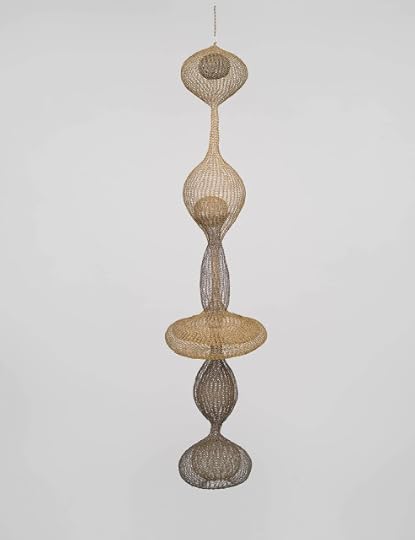Visitation Across the Hudson
Jonathan:
Right here, right nowThe fabric of the universe splits open,My culture breaks--What lies beyond appears
Briefly, like a crack in an egg,Dripping fluid.
How can the illusion be repaired,The unified field be rebuilt?
Realization does not come with text,Insight is not an eyeball, or a thought,Perhaps we expand by allowing,And when there is no greater goal,Surrender must be our path.
Hector Graceman (formerly the “Professor”) and Elizabeth Buchman (formerly "Crazy Jane")
THE CONVERSATION
HG: You pushed the button?
EB: Yes, it’s on record.
HG: Maybe you should say what we’re doing.
EB: OK. Hector and I have been talking and walking and telling one another all kinds of things, and we thought we’d share one or two of the highlights.
HG: And you gave me a gummy to eat.
EB: And, yes, I have given him a gummy to eat. Home-made: lime jello, lecithin, coconut oil, and indica sap, a nice smooth ride.
HG: On the High Line.
EB: Where we are and saw the…what have we decided to call them?
HG: Well, we accepted the commonly used “Visitation,” but you like calling them “Friends,” so that’s what we will call them.
EB: Because they brought us together and we are becoming… 1-2-3
BOTH “Friends.” (laughter)
HB: Well, this is what is most strange to me, the way these experiences have brought me out of myself and into a willingness to meet a stranger. It’s the oddest sense of at once having an experience of the “strange” and feeling a deep need to not be one myself.
EB: So, you are writing poetry.
HB: Yes, and that is a way of not being a stranger to myself.
EB: Read the new one.
HB: Really.
EB: Yes.
(pause)
HB: OK, I called it, “Autumn’s Drift.”
I caught the drift of Autumn
Glowing in the trees
The sun was warm upon my cheek
The water laughed in the nearby creek
And I was deep at ease.
I caught the drift of Autumn,
Or rather it caught me,
The golden leaves were floating down
Twinkling gems from a shedding crown
And my mind was loosed and free.
So I rode the drift of Autumn
Time lost track of me,
I came to earth with an open heart,
I felt invited to take part,
And my reply was poetry.
(pause)
EB: Oh I like the drift of the meter, the lull of it. You have a good reading voice.
HG: It’s amazing how shy I feel about making poems.
EB: Yes, that’s what I wanted you to talk about so I could record it.
HB: A classmate of mine from high school began writing poems during the Covid quarantine, and he sent them out to members of the class of ’59 for whom he had email addresses, and subsequently he and I made contact by phone. We had some nice conversations. And I asked him about his poetry, and he said that this was the first time he had shared them. Poetry had always been a private thing, and he said he was “shy” about it, and then he said he had a therapist once who told him that “Shyness was the outer level of the heart.” I thought that was lovely.
EB: It’s the vulnerability.
HB: Yes, exactly, and somehow the Visita---the “Friends”---have made me feel my vulnerability, and I think everyone is feeling that who has seen them live. But I think this gummy has made me feel more open and less vulnerable, less like showing myself will open me to hurt, or shame, but rather than to…EB, what’s the word I’m looking for?
EB: For me the word is “aliveness.” And it’s the next layer in of the heart, the actual feeling of being alive in the world and loving it.
HG: Is there anything deeper than that in the heart?
EB: You caught in it your poem, Horace, when you knew “rode the drift of Autumn” and “Time lost track” of you, rather than you losing track of time. You were one with the moment, and you responded with a poem that shared this moment of aliveness.
(Silence)
HG: I think you could turn that recorder thing off now.
(click)
HG: Is it on?
EB: Yes, it’s on, Hector.
HG: So say something about your art.
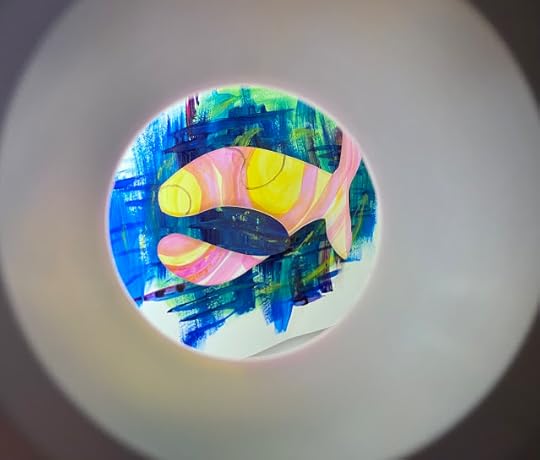
EB: I don’t like the word art. It rhymes with smart and fart.
HG. And heart.
EB: Yeah well…Art is a category and it is first and last a verb, and when it becomes a noun it has lost its living relation to the process of it own becoming, which is the only place the maker really feels alive, to use that word, and to which one wants to return…like your drift… that’s where making art can take me, but not into words but into my hands and eye.
(pause)
You know you can say all kinds of things about a poem, because it’s in words, and words are all ravelled up in meanings and history and associations, but pictures are like dance or music, they don’t need words and frankly don’t want them. Let’s just say I’m having fun, and if you want to use words, Hector, be my guest. What do you see?
HG: Well, I think you’re making a joke. I think you are responding to the appearance of the “Friends” by saying that there’s something “fishy” going on. I mean that’s where this all began for me, with the sense of the anomalous, that really is the sense that something is not maklng sense by any of the usual criteria. Something is “fishy” here. And I go from that to thinking of the fish in the hook of Jonah, the Leviathan, the fish that swallows up the prophet, humbles him, brings about in the end repentance. And that leads me to my own feelings of dislocation. And maybe there’s in the Visitations something that is not friendly, but foreboding, apocalyptic.
(pause)
EB: You finished?
HG: I could go on I suppose, but I can see this is not giving you any particular pleasure.
EB; Well, I can see why you called yourself “Professor,” but I suppose I have to admit that if you have to use words, those are pretty good ones.
(click)
Nagatoshi Amemiya, Ruth Asawa Through Line, in Artists Review Art, October 23, 2023, p.5.
(Whitney Museum of American Art, New York, September 16, 2023–January 2024).
The Whitney's belated tribute to Ruth Asawa says more about the museum than her work. Kim Conaty, the Steven and Ann Ames Curator of Drawings and Prints, says, in an accompanying essay, that drawing was "Asawa’s private world, a place where she could take her time to watch, listen, see, feel, and draw." How sweet.
These small drawings, the delicate paperfolds, ask to be looked at close up. They are not bold statements designed to be seen from a distance. But Conaty has made these works seem even tinier by placing them in low rows on very high walls, significantly painted white, at the far edge of a well polished floor. I read this installation as a polite dismissal of her work.
Where are her sculptures? And where is her life? Ruth Asawa, 1926–2013, began making art when held in internment camps during World War II, after the Army forced her family off its farm. At that time, white people feared that ,as Japanese Americans, her family might somehow aid a foreign invasion on the West Coast. Asawa began making sculptures with materials at hand, bending wire, making globes, circles, spirals, columns out of this resistant metal, tough but pliable, like her.
Untitled (S.270, Hanging Six-Lobed, Complex Interlocking Continuous Form within a Form with Two Interior Spheres), 1955, refabricated 1957–1958, Whitney Museum of American Art, New York; gift of Howard Lipman.
By choosing to center the show on delicate personal drawings, Conaty encourages viewers to dismiss, or undervalue Asawa’s complex, logarithmic, intensely worked life, and the otherworldly forms that emerged.
Outside of the Whitney, though, as you have probably seen on the news, I spotted this Visitation coming across the Hudson, and felt, for a moment, truly surprised, then up-lifted, glad to be free of this austere but lifeless exhibition.
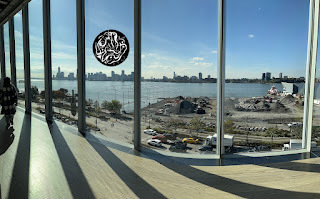
--Jonathan Reeve Price and Peter Asher Pitzele
To explore the sequence of Visitations:
Visitation on a Clear Day
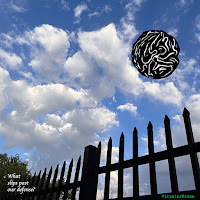
Visitation in the Smoke
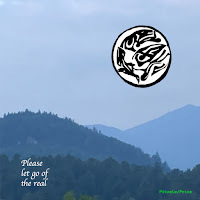
Visitation in the Haze
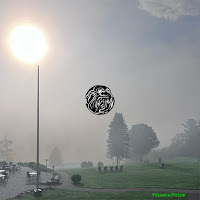
Visitation Arriving at Dawn

Visitation on the Rio Grande
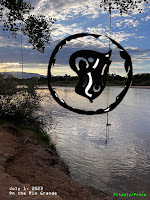
Visitation on a Maine Summer Day

Visitation in Brooklyn
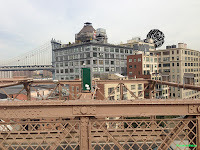
Visitation in Midtown
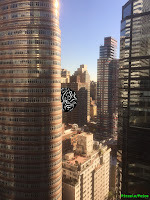
About Jonathan
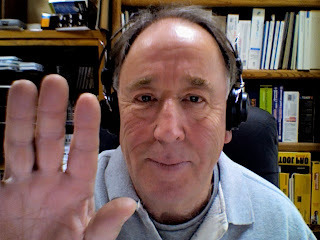
LinkTree: https://linktr.ee/jonathanreeveprice
MuseumZero site: www.museumzero.art
Twitter: http://twitter.com/JonathanRPrice
Instagram:
Pinterest:
Facebook:
Linked In:
Amazon Author Page:
Goodreads:
https://www.goodreads.com/author/show/41600924.Jonathan_Price
About Peter
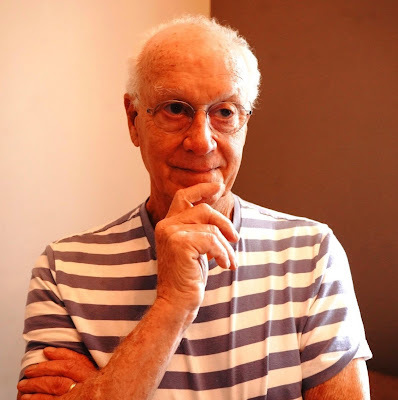
Instagram: https://www.instagram.com/peter.pitzele/
Scripture Windows: Toward a Practice of Bibliodrama, with Susan Pitzele
Our Fathers' Wells: A Personal Encounter With the Myths of Genesis



